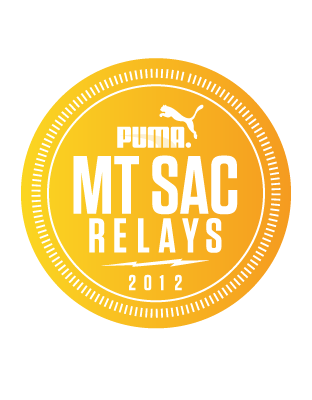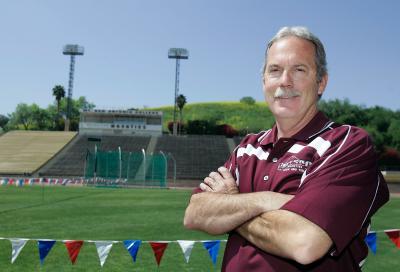Doug Todd is the Meet Director of one of the largest Track & Field Relays in our sport, the Mt.SAC Relays. The Mt.SAC Relays have given many athletes, young and elite, a chance to compete in the late April for over fifty years.
This year’s event is April 18-22, 2012, and we were fortunate to grab Doug Todd, Meet Director of the Mt.SAC Relays, and ask him a few questions about the fabled meet. Note that Flotrack.org will be covering the PUMA Miles this year as many of the other parts of the Mt.SAC Relays.
We encourage one and all to attend and see a tremendous weekend of track & field. This year, will have some very fast sprints, the PUMA miles, and a superb Distance Carnival!

RBR, #1: Tell us about the Mt.SAC Relays
this year?
Doug Todd: It’s going to be a great meet. We have over 350 Universities entered,
200 plus high schools, and despite the fact that there are a number of ‘area.’
championships going on during the Relays weekend, it looks as if we are
getting all of the top HS kids as well. Our elite division is also very
strong, one of the best in recent memory.
RBR, #2: How do people get tickets?
Doug Todd: We recommend purchasing tickets online at tickets.mtsac.edu, but you can
always purchase onsite at the gate as well
RBR, #3, If someone has never been to Mt. SAC relays, what are the key events?
Doug Todd: The Friday night distance carnival – it is a great event featuring some
of the best runners in the US and from around the world. You also
can get an amazing up close and personal view of the athletes competing
on the track level for the PUMA Mile – A classic one-mile length race
aimed at promoting the prestigious goal of breaking the 4 min mile for men, or 4:30
for women. There will be both a men’s and women’s race this year
and over $10, 000.00 in prizes.
Saturday’s events are also not to be missed – from noon to 5 pm, you can
see the crème de la crème for all divisions. And finally, our new
shot put arena that allows fans to be right on top of the throwers and
see and hear them compete and get after it.
Don’t forget the In N Out Burgers and Robeks Juice; they both are amazing….I
live on that for three days straight!
RBR, #4: Do you have a distance carnival?
Doug Todd: Yes. Thursday and Friday night, Thursday is Steeples and 10,000M,
Friday is 5k’s , Miles, Distance Medleys, and elite 4 x 1600 for the preps.
RBR, #5: What is your favorite part of the Relays?
Doug Todd: Saturday afternoon, when the stands are full, a million things are happening
and all is under control!
RBR# 6: I enjoyed my years viewing the Mt. SAC relays; what will be some of the highlights this year?
Doug Todd: The Women’s 5 K, the PUMA Miles, the Pole Vault, and the Men’s Long Jump
– just to name a few.
RBR, #7: Can you give us a bit of the history of the Mt.SAC Relays? When did it begin?
What are the keys to its success?
Doug Todd: See attached history document (shown at end of interview).
RBR, #8, PUMA is your major sponsor; what do they do for the Relays?
Doug Todd: They bring excitement to the event that we have not seen in a long time.
Their activation at the Relays has been second to none, and I think they
know how to do that as well as anyone. It has been a great partnership,
the Relays and PUMA each working together in our areas of expertise, makes
for a great experience for both athlete and fan.
RBR, #9, You had a spectacular clinic last fall hosted by Usain Bolt. Can you tell us about that? Doug Todd: It was a great experience! We had over 3000 people attend, it was
amazing. Bolt was able to interact with students and give them insight
and tips on his training process. The students were thrilled and
everyone had a lot of fun.
10. Where can people find info on the meet?
www.Mtsacrelays.com
<www.Mtsacrelays.com>;History of Mt. SAC Relays:
Hilmer Lodge was only with the Mt. SAC Relays for a relatively short time, but his impact on it and track and field in the US was profound. In preparation for his first Mt. SAC Relays event, Hilmer convinced the Mt. San Antonio College Board of Trustees to construct a state-of-the-art track and field facility inside an already beautiful stadium complex. When completed, it was considered one of the fastest all-weather tracks in the world. The composition was of volcanic ash, clay and diatomaceous earth.
It was on a cold afternoon of April 24 and 25, 1959, that Lodge’s bold plan to put on a major Relay carnival on the west coast to match those of the well-established Penn and Drake Relays turned into reality. He wanted his event to coincide with the dates of America’s traditional early season meets but not to limit the competition to prep and collegiate-level athletes. He also wanted America’s postgraduate, club, and open athletes to compete as well. Moreover, he wanted women to have opportunities equal to the men.
Thus, in 1959 a major track and field meet was born on the West Coast, unique from any others in the US. At the conclusion of the 1959 affair, Track and Field News reported, “The first annual Mt. SAC Relays got off to a good start with first-class performances in every event and excellent standards of achievement in all areas. The West Coast’s only two-day affair outclassed the old established meets by a wide margin in a comparison of winning performances.”
Hilmer retired in 1963 and moved with his wife Dorothy to Pala, California, to devote full time to his citrus ranch, which had previously been just a hobby. From his first Relays in 1959 through his retirement in 1962, the event had grown from 850 high school, community college, college, and club athletes competing in 56 different events over a 14-hour period to one of two days consisting of 139 events, 19 hours, and almost 3000 athletes. In that same span, the new facility (combined with Lodge’s involvement in national and Olympic track and field) attracted our US Olympic Team to Mt. SAC for its 1960 and 1964 training and trials site and in 1968 for one of its two trial venues.
While Hilmer continued his involvement in the relays after his retirement, the school’s second track coach, Don Ruh, assumed the day-to-day duties of the meet as its manager and director for the next 24 years. During that period, the event continued to grow in size and popularity while maintaining its claim of being the US’s number one performance meet. By 1985, the Mt. SAC Relays had become the largest meet in the world. By that time, the competition portion of the meet extended over 50 hours, 6 days, 350 events, and over 9000 competitors.
The Relays became an international affair as athletes started coming from around the world looking for quality competition in near-ideal conditions. A usual Relay had teams from 18-20 nations present, with Mexico, Canada, and Australia traditionally sending the largest contingents. In 1980 a diplomatic coup took place at the Relays when a team from the People’s Republic of China agreed to meet Taiwan for the first time since their countries’ separation over 40 years earlier. This historical event opened the door of cultural and sports exchanges from that time on. In this same era, traditional Southern California track and field events, such as The Coliseum Relays and the Compton Relays, fell by the wayside because of severe financial problems.
The Mt. SAC Relays continue to survive as a nonprofit event because of its strong network of volunteers. This group of dedicated officials and the lay Games Committee work tirelessly to ensure the success of the Relays. In 1986, a former Mt. SAC athlete, world record holder and Olympic pole vault gold and silver medalist, Bob Seagren, returned to Mt. SAC as a Vice-President of Puma USA to give the Relays its first major sponsorship.
The new Puma Mt. SAC Relays was given a much-needed boost while the original philosophy of the event was maintained. The “Tradition of Excellence” of the Mt. SAC Relays continues to the present day.
In 1984, the success of the Los Angeles Olympic Games prompted the formation of The Amateur Athletic Foundation of Los Angeles to promote sports among the youth of Southern California. In 1986, the AAF selected the Mt. SAC Relays as its first-ever grant recipient. This honor allowed the Relays to expand its program to include boys and girls to participate in two special AAF-Mt. SAC Relays Youth Days. This would never have been financially possible without the support of the LA/84 Foundation. This program, along with the instructional clinic program, has grown each year; over 250,000 youth athletes have actively participated since the inception of the program.
With the ever-increasing need for AAF-Mt. SAC Relays coordination and Olympic development programs, Ruh passed the directorship of the Relays on to a long-time track and field enthusiast, Dan Shrum, in 1988.
Also, at this time, Dr. Ernie Gregoire, the long-time Women’s Division Chairman, assumed the role of Executive Director. Mazda served as the major sponsor from 1989 through 1992. The 1992 event, which was seen nationwide on television, showcased 15 eventual gold medalists from the 1992 Barcelona Olympics, along with 10 silver and 7 bronze medalists. No other US meet came close to matching this level of quality.
In 1997 the directorship of the Relays was passed on to Scott Davis, who served as the Assistant Director and long-time announcer of the event since 1982. Dr. Gregoire retired from the college but remained on assuming the position of Relays Marketing Director. Deborah Blackmore, the college’s Dean/Athletic Director, took over the role of Relays Executive Director.
In 2006, Doug Todd, Mt. SAC’s Director of Cross Country and Track and Field took over as Relays Director. Scott Davis remained on as the Relays Coordinator but retired at the conclusion of the 2008 event.
In 2009 the Relays was restructured with Todd continuing as the Relays Director with the following individuals serving as divisional coordinators: Youth Days – Don Ruh, Community College – Mike Goff, High School – Tim O’Rourke, University – Ron Kamaka, Elite – Brian Yokoyama.
The Mt. SAC Relays exists because of the long-time dedication and hard work of hundreds of volunteers and supporters. Moving into our second 50 years of excellence, we look forward to new chapters of is due to the individuals and the talents of the many athletes who have graced Hilmer Lodge Stadium with their performances.

Author

Larry Eder has had a 52-year involvement in the sport of athletics. Larry has experienced the sport as an athlete, coach, magazine publisher, and now, journalist and blogger. His first article, on Don Bowden, America's first sub-4 minute miler, was published in RW in 1983. Larry has published several magazines on athletics, from American Athletics to the U.S. version of Spikes magazine. He currently manages the content and marketing development of the RunningNetwork, The Shoe Addicts, and RunBlogRun. Of RunBlogRun, his daily pilgrimage with the sport, Larry says: "I have to admit, I love traveling to far away meets, writing about the sport I love, and the athletes I respect, for my readers at runblogrun.com, the most of anything I have ever done, except, maybe running itself." Also does some updates for BBC Sports at key events, which he truly enjoys. Theme song: Greg Allman, " I'm no Angel."
View all posts



















